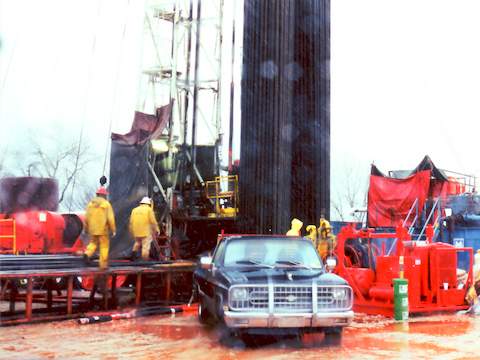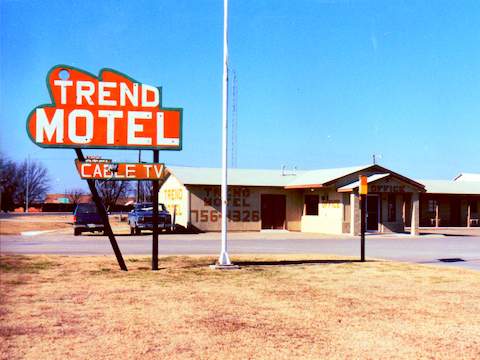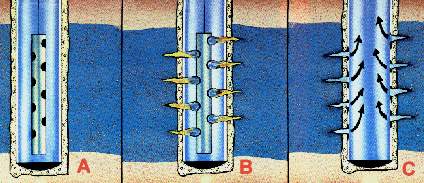Completing the Oil or Gas Well
Making the Decision to Complete
Back at the office, after a new hole is drilled, it will be necessary to talk about completing the well. Two geologists might have a conversation like this:
Bud Barclay: Tom! Good to see you! How was the drilling?
Tom Swift: Oh, just the typical heck-hole. Mud a foot deep, never stopped raining.
Bud Barclay: Zowee! I’ve got the mud log right here! The top of the sand is at 6,622′. Holy Smoke, we had a great show! Streaming oil cut and 600 units of gas!
Tom Swift: I have the electric logs here…let’s take a look at that sand! Let’s see, at 6,622’…Gee whiz! The density-porosity and resistivity look great! That sandstone calculates as a jam-up oil zone!
Bud Barclay: Leaping lizards, Tom! We sent sidewall core samples of that sandstone off to the lab so they could measure the contents of the pore space. What did the lab say about the tests?
Tom Swift: Yeh, I gave them a call from the Trend Motel. They said the porosity was 10%, and the porosity was saturated with 80% oil and 20% gas. Let’s think about this…1 cubic foot of sandstone contains .10 cubic feet of pore space (1
cubic foot X .10% porosity). If that pore space is 80% oil-saturated and 20% gas-saturated, that means there are .08 cubic feet of oil in place inside each cubic foot of sandstone, and also .02 cubic feet of gas in place inside each cubic foot of sandstone. Bud, if we knew the thickness of the sandstone and the width and length of the sand body, we could estimate the total oil in place!
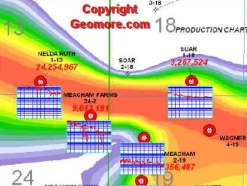
Bud’s New Map!
Bud Barclay: Holy moly, Tom! That’s a lot of cipherin’! I’ve completed a couple of new maps! Here’s my updated isopach map. That sand body is about 100 feet thick, 5000 feet long, and 300 feet wide! It’s a doozy!
(Tom Swift Thinks Out Loud, No Calculator Needed)
- Let’s see, 100 feet thick X 5000 feet long X 300 feet wide is 150 million cubic feet of sandstone!!!
- Since we already figured out that each cubic foot of sandstone contains only .08 cubic feet of oil, that means there is 150,000,000 X .08…or 12,000,000 cubic feet of oil in that formation!!!
- Since there are 5.61 cubic feet of oil to the US barrel, that’s about 2,139,037 barrels of oil in place (1,200,000/5.6)! That’s over 2 million barrels!!!
Bud Barclay: Holy Toledo! But the reservoir engineer calculated there would only be a 20 percent recovery factor for the oil. That means we will only be able to recover about 20% of the oil in place. 2,100,000 X .20 is 427,807 barrels. Great Scott! Four hundred thousand barrels sounds A-OK to me! Plus, it’s pretty shallow at 6600′, so it won’t cost very much to drill!
Tom Swift: Yes, and every single barrel counts! By jiminy, our country needs energy! And every barrel we can produce at home is a barrel we will not have to import! Who wants to depend on outsiders for everything? Bro, they might cut off our energy supplies! Homegrown energy keeps the country strong!
Bud, tell the boss we expect this well to produce oil and gas, and we’ll propose another well soon! With luck, this new well will be producing by October! That will provide more energy for home heating this winter!
Bud Barclay: Roger Wilco, Tom! I’ll tell the production engineer we want to run casing, then perforate a 100′ interval from 6,622′ to 6,722′! Then I’ll go upstairs and tell J.D. we hit a home run!
The Start of the Completion
The completion of the hole is mainly in the hands of the petroleum engineer. The basics are briefly covered here:
The main parts of a completed well are the oil or gas-bearing formation, the drilled hole, many lengths of steel pipe, cement to hold the pipe in place, a set of perforations, a surface well-head connection, and possibly a pump.
After it has been decided that the hole will be completed, steel pipe is run all the way to the bottom of the hole and cemented in place. This stops oil, gas, and salt water from coming into the hole from formations above the 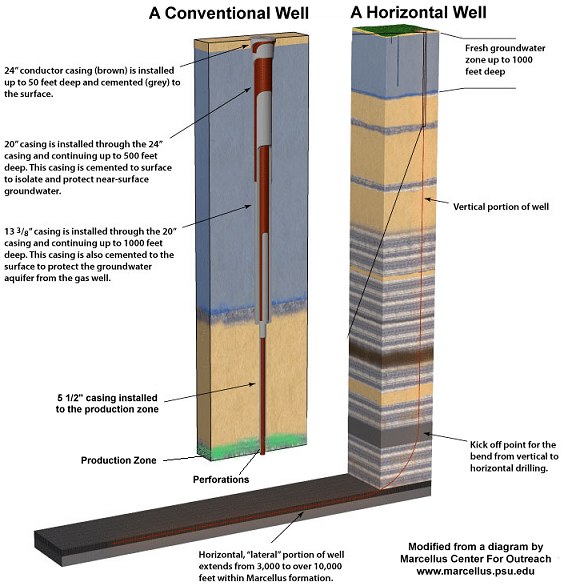 pay zone. In the example well, conductor casing extends from the surface to approximately 50′ depth. Then surface casing is installed to approximately 500′. A 13 3/8″ casing is run to approximately 1000′. All these casings serve to protect the ground water. The casings overlap, so that there are 4 layers of casing at the surface! Finally, a production string of 5 1/2″ casing will cover the rest of the hole to the bottom.
pay zone. In the example well, conductor casing extends from the surface to approximately 50′ depth. Then surface casing is installed to approximately 500′. A 13 3/8″ casing is run to approximately 1000′. All these casings serve to protect the ground water. The casings overlap, so that there are 4 layers of casing at the surface! Finally, a production string of 5 1/2″ casing will cover the rest of the hole to the bottom.
Perforating
A device called a perforating gun (picture A) is lowered into the hole at the depth where the oil or gas formation is found. This may be anywhere from several hundred feet down to tens of thousands of feet.
After the gun is lined up properly, powerful shaped explosive charges are fired (picture B) from the control panel in the truck…up at ground level. These explosives blast a hole in the steel casing and cement, up to several feet out into the rock. Finally, the oil and gas fluids flow into the holes and up the well to the surface (picture C).
The petroleum geologist is able to control exactly where the perforations go. This is very important, because salt water-filled zones may be immediately above or below the target zone. By carefully selecting the perforation interval, she can limit the amount of undesirable fluids – like salt water – entering the hole, and maximize the amount of hydrocarbons that can be removed from the well.
A mistake in perforating can sometimes be fixed, but fixing a bad perf in the wrong place is expensive, time-consuming, and does not always work. If a bad perforation cannot be fixed, a decision must be made: (1) Will we be able to dispose of the produced salt water safely and economically? (2) Should we completely abandon the zone? These are decisions the PG does not want to face, so perfs are selected very carefully.
Fracking
After the new drilled hole is perforated, it may produce naturally – without any sort of pump – IF the reservoir is excellent. It would then be a flowing well. Most of the time, though, the well must be fracked. During the fracking process, large amounts of fluids (such as water, carbon dioxide, or diesel oil) and other materials (such as sand or man-made proppant) are forced down the hole (in a procedure known as a frac job), thru the wellbore perforations, and into the producing zone. This combination of high pressure and proppant material fills the new fractures in the rock, creating spaces or channels of artificially-high porosity and permeability.
Fracking has been practiced extensively for over 80 years, but you would not know this based on recent news articles! In virtually all cases, fracking is a safe procedure which poses no risk to the the environment, or to the water quality of drinking-water wells. Fracking is normally done in well-isolated zones many thousands of feet beneath the surface. Most drinking water is retrieved from wells that are less than several hundred feet deep. The dangers of fracking have been very overblown.
Horizontal Well Completions
The horizontal well is completed in the same way as the vertical well, except the drill pipe is “kicked off” or turned at a certain vertical depth, which allows the drill bit to enter the prospective formation horizontally. Casing is still run all the way to the end of the hole (the steel casing bends, believe it or not), and the well is perforated and fracked in the same manner as the conventional vertical well. However, the frac is likely to be much larger in a horizontal well, as there is proportionally more rock to fracture.
If the workers feel the well is capable of producing oil, and it does not flow naturally, a pumping unit of one type or another will be placed on the well. This may be a surface pump jack, a gas-lift system, or a downhole submersible pump. Many wells may flow naturally for several years without a pump.

